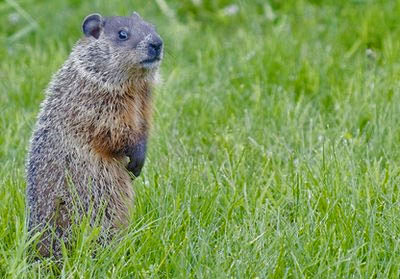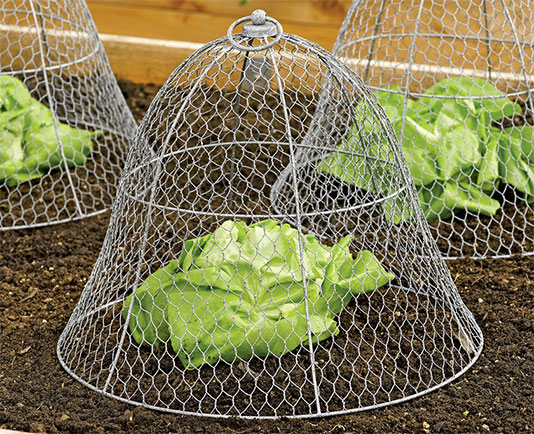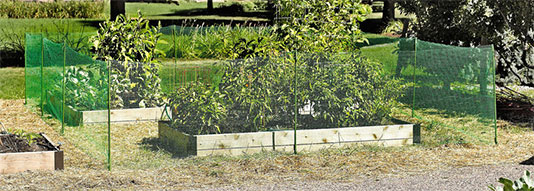





As a founding employee of Gardener's Supply, I wore many different hats over the years. Currently, I have my own company called Johnnie Brook Creative. The gardens around my home in Richmond, VT, include a large vegetable garden, seasonal greenhouse, cutting garden, perennial gardens, rock garden, shade garden, berry plantings, lots of container plants and a meadow garden. There's no place I'd rather be than in the garden.
WHAT are nature-loving, generally peaceful gardeners to do when voles, woodchucks, squirrels, gophers, rabbits, moles, and other furry little mammals wreak havoc in our gardens? Though the first impulse may be to grab a shotgun like Elmer Fudd and blast them to smithereens, there are some viable alternatives:

Woodchuck
1. Start by identifying the creature that is causing the damage and then learn a little about the habits of that animal. This knowledge is essential for putting together an effective solution.
2. Make your garden less attractive to wildlife. Eliminate hiding or nesting areas, such as brush piles and tall grass. Seal off access to crawl spaces beneath your porch or deck. Minimize other food sources: covering your compost pile will discourage raccoons, cleaning up birdseed will discourage squirrels, and using Milky Spore and beneficial nematodes on your lawn will reduce grub populations, which are a favorite food of moles and skunks.
Learn what to do when these animals come between you and your garden.
3. Consider some of the following control methods and choose the one(s) most appropriate to the pest and to your particular situation.
Eradication. Shooting the perpetrator is probably not an option, whether that’s by choice or because of zoning restrictions. There are poison baits that are effective against some pests, but they pose a danger to pets. Smoke bombs and scissor traps kill certain types of pests, but are a gruesome solution.
A more humane and holistic approach is to figure out how to coexist with wildlife; to let these animals to go about their lives as we go about ours.
Repellents. Scent repellents, such as garlic clips, castor oil and predator urine can be effective temporary solutions but they need to be monitored and reapplied to remain effective. Products made with hot peppers can deter nibbling rabbits. Some types of plants, such as castor bean and fritillaria, are said to discourage rodents. Mothballs are sometimes used as a scent deterrent, but must be used with caution as they are poisonous to pets and children.
Visual and auditory scare devices can be used to repel animals. These include ultrasonic repellers, motion-activated water sprayers, noise makers, and visual scare devices such as reflective tape and faux predators. The effectiveness of these devices usually diminishes over time as pests may become familiar with them. Surprise is the effect you’re after, so plan on changing up your strategies.

The Chicken Wire Cloche protects prized seedlings, lettuce plants and ripening strawberries from nibbling wildlife and curious cats.
Pets. Dogs and cats can be a nuisance in the garden, but they can also be useful for keeping furry pests under control. Cats are especially good at catching voles and gophers, and dogs can be good at deterring or sometimes even nabbing furry pests.
Live Traps. These traps, usually made of galvanized steel mesh, come in a number of different sizes. Vegetables, crackers, or some other food is used to lure the animal inside. A spring-loaded door closes, locking them in. It’s quite easy to catch a woodchuck, rabbit, squirrel or chipmunks in a live trap. What’s trickier is figuring out what to do if and when you catch them. Some states prohibit the relocation of wildlife. If it is permitted, it can still be cruel to the animal and probably to the gardeners who live in the new area. For more information: Animal Trapping Techniques.

The soft polyethylene mesh and sturdy plastic poles of the Pest Fence provide a 42" high barrier around vulnerable plants.
Fences. Exclusion is certainly the most effective, long-term solution. A fence can be permanent or can be strictly a temporary, seasonal solution that’s put up and taken down as needed. Mesh fencing can be cut to size and stapled or tied to fence posts. An electric fences is the ultimate solution — especially for woodchucks, rabbits and deer. Though it requires an investment of time and money, it’s the best way to provide complete protection for your crops, while letting wildlife go about their own business. For more information about fencing: Animal Fencing Techniques.
Copyright © www.100flowers.win Botanic Garden All Rights Reserved